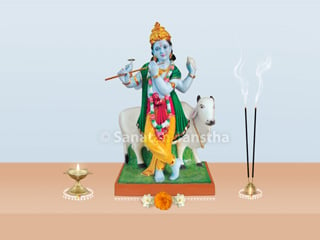The word ‘ashram’ has been derived from the root ‘shram’ which means to make efforts.The meaning of the derived word ‘ashram’ is a state in which one makes efforts on one’s own.
Objectives and type
Righteousness (dharma), wealth (artha), desire (kama) and the Final Liberation (moksha) are the four pursuits (purushaartha) of human life according to Bhaartiya (Indian) culture. The system of ‘stages of life’ (ashrams) explained in the Vedic religion is the principal means of attaining them. When explaining the duties to be performed in the various stages of life, the lifespan of man has been considered as 100 years and has been divided into four parts. Each part is called a stage (ashram).
The four stages are :-
- Celibate (Brahmacharya) : In the stage of celibacy one has to live in the Guru’s hermitage, study the scriptures and undertake vowed religious observances (vrat).
- Householder (Gruhastha) : In the stage of a householder; through procreation, performing fire sacrifices (Yadnyas) and study of scriptures one repays the three debts towards society, ancestors and God respectively.
- Retired householder (Vanaprastha) and Renunciant (Sannyaas) : As one ages one has to retire to the forest to complete the third stage of retired householder. This is beneficial in gradually detaching oneself from desire and attachment for wealth. Lastly, towards the end of life one should renounce the world and attain the Final Liberation (moksha) through Self-realisation, accomplishing the very purpose of life according to this philosophy.
Restricting the natural tendencies of human being and guiding it on to the right path by defining limits is necessary to accomplish any of the four pursuits (purushaartha) of human life. Realising that this objective would be fulfilled only if human life was regulated by the four stages of life, this system was laid down by the sages. The absolute means to accomplish the ultimate objective of human life, which is the Final Liberation or eternal benefaction, is the stage of the renunciant. To accomplish the spiritual practice (Sadhana) of that stage, the first three stages are essential. Thus the four stages are inter-related. In short, the system of ‘stages of life’ teaches a materialist what spiritual practice he should undertake to gradually adopt the path of Spirituality (nivruttimaarg) as his age advances.
Importance
The ‘stages of life’ are absolutely essential to decrease attachment for the Great Illusion (Maya), reduce awareness of the body (dehabuddhi), to consider others as a part of one’s family and to assuage the ego.
Distortion of present era
A) One is supposed to live in the Guru’s hermitage known as ‘Gurukuls’, which have now been replaced by schools and colleges. Many live in hostels. The environment in these establishments are induced as a daily routine. In addition, college and television culture create a materialistic environment. Parents and teachers play no part in building the character of the students. Moreover, there is no provision in any curriculum to inculcate spiritual culture among youngsters of today.
B) After spending a good part of their lives in such raja-tama conditions, when an individual commences his life as a householder, his only objective is to earn as much money by any fair or foul means. He is so engrossed in his family life and makes most of material gains that he does not find any time or makes any efforts to remember God, leave alone performing any sort of Sadhana or religious rituals to imbibe Sattvikta (Purity) from the cosmos.
C) Even if he reaches old age i.e. of retired house holder (Stage of Vanaprasthashram) his lust for money and other pleasures of material world do not seem to reduce. He hankers for more and more of these illusions even though he may be physically and mentally incapable of enjoying the fruits of his labour.
D) When such individuals experience terminal illness or when death is staring in the face, some of them start some sort of Sadhana like chanting or rituals connected with worship. But it is too late for them to accrue any benefit out of these superficial efforts.
Compiled by : Shri Abhay Vartak

 Maghi Shri Ganesh Jayanti 2025
Maghi Shri Ganesh Jayanti 2025 Memories of Param Pujya Bhaktaraj Maharaj
Memories of Param Pujya Bhaktaraj Maharaj Greatness of Shani Devta (Planet Saturn)
Greatness of Shani Devta (Planet Saturn) Partial lunar eclipse of October 2023 – Do’s and Don’ts
Partial lunar eclipse of October 2023 – Do’s and Don’ts Main places of pilgrimage of Deity Datta
Main places of pilgrimage of Deity Datta Photographic Divine vision of some places which have experienced Shrikrishna’s blissful presence !
Photographic Divine vision of some places which have experienced Shrikrishna’s blissful presence !